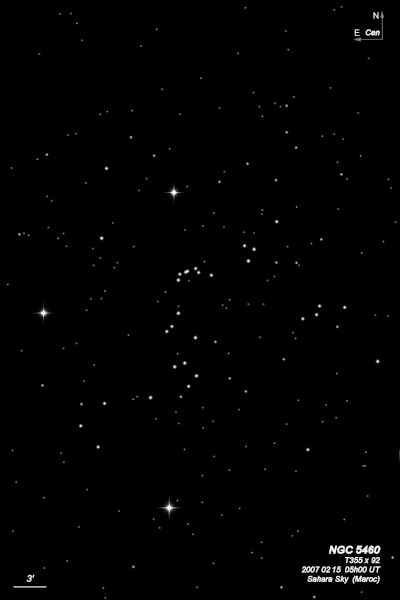
James Dunlop discovered NGC 5460 = D 431= h3555 on 7 May 1826 from Parramatta with his 9.75-inch speculum reflector and described "a curiously curved line of small stars of nearly equal magnitudes; two stars of 7th magnitude following." He observed the cluster 3 times. John Herschel first observed the cluster on 6 Aug 1831 and recorded "a region of large, bright stars, 8, 9...etc. mag; a very coarse cluster. Place that of a brilliant group, one of which is a double star class III." Two nights later he wrote, "Place of a double star in a semi-elliptic group forming part of it, but insulated in a large scattered cluster or tract of bright stars." On a later sweep he logged "a region of large stars very loosely distributed, but which yet decidedly form a cluster. Place that of a pretty close double star (four arcseconds) in the middle of a group of 8. The cluster is 30' diameter, and is divided into distinct groups."
300/350mm - 13.1" (3/17/86): about three dozen stars, bright, large, includes several double stars. Appears scattered with stars arranged in distinct groups with a tight chain in center. Located 23' N of mag 6.4 HD 123247. This is one of the southernmost clusters visible from Northern California sites, but was still very pretty.
400/500mm - 22" (6/28/06 - Hawaii): this bright, very large cluster of ~120 stars extends to 30' diameter at 110x. Many of the brighter stars are arranged in a very distinctive winding curve (fractured into groups) that snakes from NW to SE. At the center is a looping chain of eight mag 7 to 10 stars including a nice double h4647 = 9.3/9.6 at 11". At the NW and south ends are hooks of stars like the tail end of Scorpius. ESO 221-25, a faint galaxy, is hidden among the brighter stars and was not noticed.
Notes by Steve Gottlieb